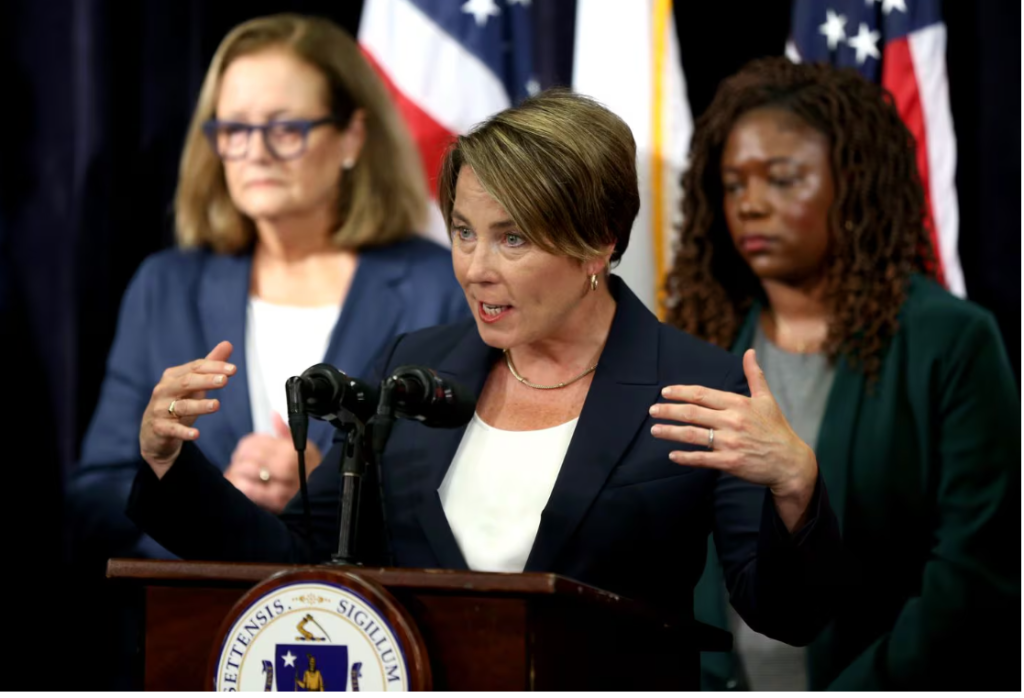【中美创新时报2024 年 6 月 12 日编译讯】(记者温友平编译)马萨诸塞州官员周三(12日)宣布,根据希利(Healey )政府实施的新政策,居住在该州紧急庇护系统中的无家可归和移民家庭可能最早于 9 月 29 日被赶出。《波士顿环球报》记者萨曼莎·J·格罗斯(Samantha J. Gross)对此作了下述报道。
根据新政策,第一批退出紧急援助计划的家庭将从 7 月开始亲自或通过电子邮件收到 90 天的退出通知,新政策将庇护所停留时间限制为连续 9 个月。官员表示,具体日期尚未确定。
该政策将分阶段实施,因此并非所有家庭都会立即受到影响。首先,每月将通知 150 个家庭。
官员表示,大约有 4,000 个家庭(其中约一半是移民)已经在避难所待了 9 个月或更长时间。
虽然大多数家庭必须在 9 个月后离开,但该政策允许某些个人(如退伍军人、残疾儿童的单亲父母或在获得工作许可方面取得进展的人)多次延长 90 天。它还为面临某些困难的人提供了申请 120 天困难豁免的选项。
家庭的离开日期将根据他们被安置在紧急避难所的日期确定,家庭可以选择重新申请,但要取决于候补名单和其他因素。
新政策反映了立法机构 4 月通过的一项规定了 9 个月期限的法律的实施。该提案是一项更广泛的支出法案的一部分,旨在支撑紧张的庇护系统度过本财政年度,并帮助其在 2025 年之前获得资金。
由于家庭和支持者对该政策的实际生效时间感到普遍困惑和担忧,政府不得不在周三澄清日期。
本月早些时候,希利政府官员表示,在收到 6 月 1 日 90 天的退出通知后,家庭可能会在 9 月 1 日开始被踢出紧急庇护系统,信息反映在州网站上。
官员表示,网站将更新新政策、解释视频和常见问题解答。当家庭在庇护所度过最后几天时,他们还将收到提醒电子邮件。
该州还将张贴传单、分发资料包,并培训该州 211 呼叫中心的工作人员回答有关新政策的问题。
自马萨诸塞州的庇护权法颁布以来,九个月的限制标志着该州对无家可归家庭的紧急庇护系统首次实施限制。直到最近,根据这项已有数十年历史的法律,无家可归的家庭可以无限制地获得住所,这是美国唯一一项全州范围的所谓“住房权”要求。
纽约市也有类似的住房政策,对新移民在紧急避难所停留的时间施加了更严格的限制:在那里,有孩子的家庭最多可以在避难所停留 60 天,尽管有人试图废除这项政策。
在马萨诸塞州,移民危机近几个月来愈演愈烈,每月都有数百人抵达该州,逃离海地和委内瑞拉等祖国的暴力和经济动荡,导致该州损失数百万美元。
众议院议长罗恩·马里亚诺 (Ron Mariano) 周二称该州的做法“公平”,并指出它允许人们寻求延期,同时允许该州开始“从避难所迁移”。
这位昆西民主党人谈到这些限制时说:“他们早就注意到这种情况会这样,现在终于实现了。” “我并不意外这个消息。所以其他人也不应该感到惊讶。”
截至 6 月 6 日,马萨诸塞州的紧急避难所系统为 7,387 个家庭提供了住房,其中近 3,736 个住在酒店或汽车旅馆。根据州数据,该系统中大约一半的家庭(不包括候补名单上的数百人)以移民、难民或寻求庇护者的身份进入美国。
据州政府官员称,紧急避难所的平均逗留时间接近一年,为 362 天。
希利已经对避难所系统施加了一些限制,去年将容纳人数限制在 7,500 个家庭——这是该州首次限制该系统容纳多少人。5 月 1 日,州政府官员开始将州营的超员避难所的逗留时间限制为 30 天,要求人们每月重新申请,并表明他们也在寻求工作许可、寻找新住房或采取其他措施留在这个迅速扩张的项目中。
超员庇护所与州政府运营的紧急庇护所系统是分开的,用于临时安置等待进入更大系统的家庭。截至上周,有 798 个家庭在等待名单上。
致力于安置新移民的新英格兰国际研究所首席执行官杰弗里·蒂尔曼 (Jeffrey Thielman) 表示,九个月的规定可以作为“促使人们尽快离开酒店的动力”。
自去年 10 月联邦财政年度开始以来,蒂尔曼的组织已为来自海地的 11,000 多名难民提供了服务,包括获得联邦现金援助的机会——其中许多人被安置在州内各地的公寓里,而不是州政府运营的紧急庇护所,蒂尔曼说。
“最后期限对我们这样为庇护所中的人们提供服务的机构很有帮助,”他说。“我们都很清楚,纳税人不会无限期地资助紧急庇护所系统,也不会对成本设定任何上限。”
马萨诸塞州中部住房联盟执行董事 Leah Bradley 表示,虽然人们对新规则将如何影响家庭存在一些担忧,但他们指出,该州已努力加强 HomeBASE 代金券,这是一项已有十年历史的紧急住房援助计划,涵盖押金、租金和家具。
Healey 政府将两年内的租金援助从 20,000 美元提高到 30,000 美元,并有可能延长第三年。为了帮助更多家庭更快地获得该计划,被认为“推定符合条件”的家庭可以获得 HomeBASE 资金,而房东如果将房屋出租给 HomeBASE 租户,则可以获得相当于一个月租金的支票。
在过去六个月中,已有 1,540 个家庭离开庇护所:12 月有 197 个,1 月有 209 个,2 月有 230 个,3 月有 269 个,4 月有 304 个,5 月有 331 个,6 月有超过 35 个,因为州政府资助了扩大住房和就业安置服务。
麻省法律改革研究所的专职律师兼社区倡导主任安德里亚·帕克 (Andrea Park) 表示,新政策还不足以保护那些仍住在收容所的人。
她曾推动一项修正案,该修正案将从 6 月 1 日开始为期 9 个月的期限,而不是让该政策追溯生效,但没有成功。由于没有缓冲或时间来利用该州的新资源,人们“害怕”他们会“随时”收到通知。
她说,“由于缺乏明确的指导”,无家可归者和移民家庭转向谣言和不可靠的信息。
“对于人们应该做什么,仍然没有任何好的答案,”她说。“人们会问的问题是,‘那些没有准备好的人会怎么样?’这并没有太多的保证。”
环球报的 Matt Stout 为本报告做出了贡献。
题图:2023 年 8 月,马萨诸塞州州长莫拉·希利(Maura Healey )宣布进入紧急状态,以解决庇护系统和移民涌入问题。JONATHAN WIGGS/GLOBE 工作人员
附原英文报道:
State says migrant, homeless families will start getting notices to leave shelters in July
By Samantha J. Gross Globe Staff,Updated June 12, 2024
Homeless and migrant families living in the state’s emergency shelter system could be kicked out as soon as Sept. 29 under new policies implemented by the Healey administration, officials announced Wednesday.
The first families to exit the emergency assistance program under the new policy, which limits shelter stays to nine consecutive months, will receive 90-day exit notices in person and by email beginning in July. The exact date has not been determined, officials said.
The policy will be implemented in stages so not all families would be affected immediately. To start, 150 families will be given notice each month.
Officials said there are about 4,000 families — about half of whom are migrants — who have been in shelter for nine months or more.
While most families will have to leave after nine months, the policy allows for multiple 90-day extensions for certain individuals such as veterans, single parents of children with a disability, or people who have made progress toward receiving a permit to work. It also builds in the option for those facing certain hardship to apply for a 120-day hardship waiver.
A family’s exit date will be determined based on their date of placement in an emergency shelter, and families will have the option to reapply, subject to the waitlist and other factors.
The new policies reflect the implementation of a law the Legislature passed in April setting a nine-month limit. The proposal was part of a broader spending bill meant to buoy the strained shelter system through the end of the fiscal year, and help fund it into 2025.
The administration had to clarify the dates Wednesday after there was widespread confusion and concern among families and advocates over when the policy actually goes into effect.
Earlier this month, Healey administration officials said families could start getting kicked out of the emergency shelter system by Sept. 1, after receiving a 90-day notice to exit on June 1, information reflected on the state website.
Officials said the website will be updated with the new policy, a video to explain it, and an FAQ. Families will also receive a reminder email as they near their last days in shelter.
The state will also be putting up fliers, distributing packets, and training staff at the state’s 211 call center to answer questions about the new policy.
The nine-month limit marks the first restrictions on the state’s emergency shelter system for homeless families since the inception of Massachusetts’ right-to-shelter law. Until recently, homeless families were guaranteed a roof over their heads, with no limitations, under the decades-old law, the only statewide so-called right-to-shelter requirement in the United States.
New York City, which has a similar shelter policy, imposes more stringent limits on how long newly arrived migrants may stay in emergency shelters: There, families with children are allowed to stay in shelters for a maximum of 60 days, though there are efforts to repeal that policy.
In Massachusetts, the migrant crisis has ratcheted up in recent months, costing the state millions of dollars as hundreds more people arrive in the state each month, fleeing violence and economic turmoil in their home countries, including Haiti and Venezuela.
House Speaker Ron Mariano on Tuesday called the state’s approach “fair,” noting it allows people to seek extensions while allowing the state to begin “the migration out of the shelters.”
”They were on notice for a very long time that that was going to be the situation and now it’s come to fruition,” the Quincy Democrat said of the limits. “It wasn’t a surprise to me that the announcement came. So it shouldn’t have been a surprise to anyone else.”
As of June 6, Massachusetts was providing housing for 7,387 families in its emergency shelter system, including nearly 3,736 in hotels or motels. Roughly half of the families in the system — not counting hundreds more on a waitlist — entered the United States as migrants, refugees, or asylum seekers, according to state data.
According to state officials, the average stay in emergency shelter is nearly a year, at 362 days.
Healey has already imposed some limits on the shelter system, last year capping capacity at 7,500 families — the first restriction on how many people the state would house in the system. And on May 1, state officials began to limit stays in state-run overflow shelters to 30 days, requiring people to reapply monthly and show they are also seeking work authorization, pursuing new housing, or taking other steps to stay in the rapidly expanding program.
Overflow shelters are separate from the state-run emergency shelter system, serving to temporarily house families on the waitlist to get into the larger system. As of last week, 798 families were on the waitlist.
The nine-month rule could serve as “a motivator to get people out of hotels as quickly as possible,” said Jeffrey Thielman, CEO of the International Institute of New England, which works to resettle new migrants.
Since the start of the federal fiscal year last October, Thielman’s organization has provided services, including access to federal cash assistance, to more than 11,000 people from Haiti — many of whom have been placed in apartments across the state, not state-run emergency shelters, Thielman said.
“Deadlines are helpful to agencies like ours that are serving people in shelters,” he said. “We are all very aware that the taxpayers will not fund the emergency shelter system indefinitely and without any upper limits on costs.”
Leah Bradley, executive director of the Central Massachusetts Housing Alliance, said while there are some concerns around how the new rules will affect families, they note the state has worked to beef up the HomeBASE voucher, a decade-old emergency housing assistance program that covers security deposits, rent, and furniture.
The Healey administration raised the benefit from $20,000 to up to $30,000 in rental assistance over two years with the possibility of a third year of help. And to help more families access the program faster, families considered to be “presumptively eligible” can access HomeBASE funds, while landlords can get a check equal to one month’s rent if they lease to a HomeBASE tenant.
Over the last six months, 1,540 families have exited shelters: 197 in December, 209 in January, 230 in February, 269 in March, 304 in April, and 331 in May, and more than 35 in June as expanded housing and job placement services have been funded by the state.
The new policy doesn’t go far enough to protect those still living in shelter, said Andrea Park, a staff attorney and director of community-driven advocacy at the Massachusetts Law Reform Institute.
She had unsuccessfully pushed an amendment that would start the nine-month clock on June 1 instead of having the policy take effect retroactively. Without a buffer or time to make use of the state’s new resources, people are “terrified” that they will get the notice “any day now.”
She said “in the absence of clear guidance,” homeless and migrant families have turned to rumors and unreliable information.
“There still has not been any good answer as to what are people supposed to do,” she said. “The question people will ask is, ‘What happens to people who aren’t ready?’ There wasn’t much of assurance there.”
Matt Stout of the Globe staff contributed to this report.

